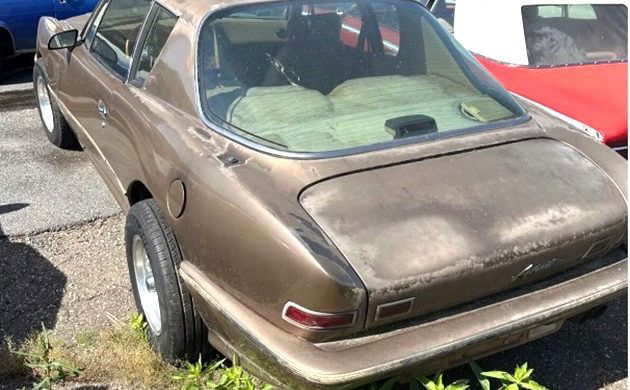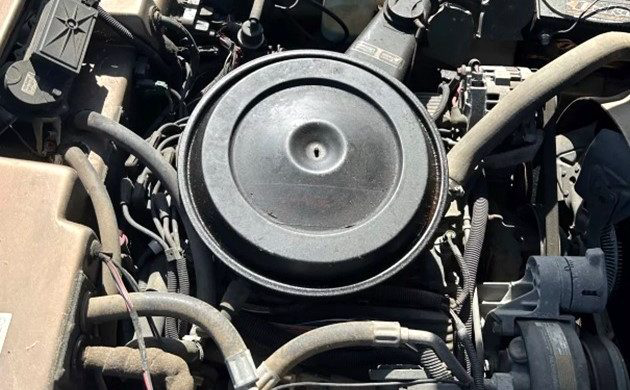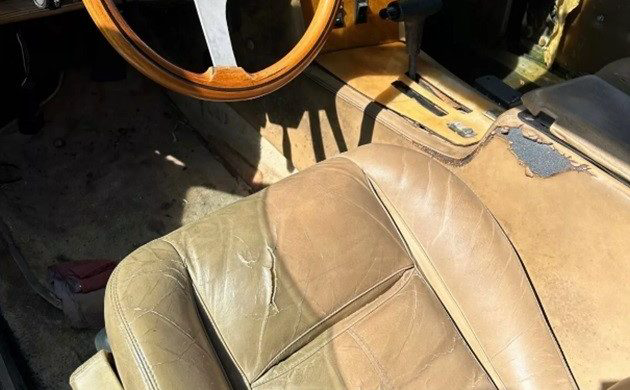
The Avanti II was the successor to the Studebaker Avanti. The original Avanti had a short life (two model years) before financial-troubled Studebaker gave up. Resurrected by two former Stude dealers, the Avanti II would live on in some form into the early 21st Century. This example is from 1989, has Chevrolet power, and needs restoring. Located outdoors in Hyattsville, Maryland, this interesting project is available here on eBay where the opening bid of $3,500 has yet to be cast.

When Studebaker shifted its remaining auto production to Canada in late 1963, the Avanti did not make the trip. Which is a shame because it was perhaps the most desirable car the company had ever built. Stude dealers Altman and Newman thought the car still had a future, so they bought the rights to the name, along with production capacity and leftover inventory, and began making the Avanti II in 1965 as the Avanti Motor Car Co. The newer cars, which weren’t replicas, used power supplied by Chevrolet because Studebaker hardware was no longer available.

This 1989 version of the Avanti II likely has a 305 cubic inch V8 under the hood, paired with a TH-350 automatic transmission. This was not a hugely powerful combination for a somewhat heavy car (though the bodies were still made of fiberglass). We’re told the engine runs, but only if you shoot some starter fluid into the carburetor. Reports are that just 200 Avanti II automobiles were built in 1989, half of them being convertibles which wasn’t a Studebaker body style.

We’re told that the seller bought this vehicle to restore it but has no time to do so. The seller says the paint has run its course, the interior is going to need some work, and likely mechanical attention will be required from sitting. A cleansing of the fuel system at a minimum seems in order. If you like the looks of the original Avanti, this car retains most of it (except for the bumper treatment). An Avanti II should be cheaper to restore than a 1963-64 Avanti because Chevy parts are more plentiful.


Yep, I like it. Easy to make it pretty if you have the bucks.
Artimis
Wonder why they didn’t use SB Ford engines?hmm makes one wonder doesn’t it?
Probably a combination of factors including cost, availability, performance/reputation, and how readily it would fit.
The initial run of Avanti IIs had the same Chevy 327 V8 as the Corvette, so it was a selling point that they had a “Corvette motor”, then later on after the 327 was no longer available, it was easier to just continue using SBCs.
They did need to raise the front end by about an inch to clear the Chevy V8’s taller intake stack, and lowered the front wheelarches accordingly to close the resulting wheel gap. Maybe a Ford alternative would have been taller yet, requiring a more compromised approach such as a power bulge/scoop or the like.
I was involved in restoring a 70 model Avanti II for a friend’s wife and even then, they were telling the “Corvette” engine story. He liked asking his Corvette buddies which Corvette they thought left the line without it’s matching engine. He had a manual he put together on that car as they had sourced parts from a lot of places when it was built. For example, he showed me how the door latches were out of some model of Mercedes, and I also don’t believe the car had a GM transmission, Borg-Warner possibly. The chassis was an old-style body on frame with a large x-member in it and he told me it was out of a Lark convertible to minimize flex and that was plausible as they had virtually identical wheelbases, 108.5 & 109.0. I never drove the 289 version but the 350 was fast. It seems like the version like this one were on a reinforced rwd Monte Carlo chassis. They wanted the Caprice as it was bigger but it’s wheelbase was too long for the dimensions (116″) and the Monte Carlo was 4″ shorter. Wish I had the parts book
No.
Given that the ’89 Avanti is built on a Caprice chassis, no, I don’t wonder why it has a Chevy engine. As for the first Avantis that were powered by a Chevy 327, they used an existing adapter bellhousing from Checker Cab to attach the Chevy engine to their Powershift automatic transmission, just as the ’65-’66 Studebakers did with a Chevy 283. Never mind that Ford V8 engines of that period used a front sump oil pan that wouldn’t fit the chassis.
Yes it does, it really does.
First off ..Studebaker never used Ford engines..Then as stated when moving to Canada manufacturing…they utilized Chevy engines .In the ’80s ..The Avanti Corp. could not obtain just the Chevy drive train..so they sourced the Monte Carlo SS…using the chassis .and thus removing and disgarding the body of such .To this day, there is an abundance of Monte Carlo SS body and interior parts from this endeavor .IE.. Mike Kelly (operations manager)…Look him up and see the “shady” dealings..
The Newman/Altman-era Avanti IIs from ’65-on did source the Chevy engines alone, and they continued building the cars on remaining old stock of Studebaker Lark convertible chassis along with other NOS Studebaker components up through ’82. This continued through the Steven Blake era up to ’85 until the stock of Lark chassis were used up.
IMO a credible case could be made that at least the Newman/Altman cars from ’65-82, and arguably the ’83-85 Blake-era cars with their relatively minor cosmetic updates, were legitimate continuations of the Studebaker original production.
There was a gap year in production for ’86 when Blake filed for bankruptcy, then Michael Kelly bought the company and resumed production, using Monte Carlo chassis for the first time. I tend to think of these ’87-onward cars as Avanti tributes rather than proper Avantis, sharing little other than their body shape with the earlier cars. Aside from the change of chassis, their interiors are also completely different. To my eye, these even seem slightly softer-edged than the earlier models, leading me to wonder if they just pulled molds off an older Avanti and modified them to cast revised fiberglass bodies that would better fit the new GM chassis.
I would agree, the Avantis produced from 65 through 82 were a continuation of the original Studebaker model. The 65 and 66 Studebakers used GM engines and the Checker produced bell housing to mate with the DG/BW transmissions. So not much difference there.
The two biggest changes was the front end changes for the larger engine and then in the early 70s for the new bumper standards.
The fit and finish on the 65-82 Avantis was arguably better than what Studebaker produced. Avanti II models are under appreciated and remain undervalued versus Studebaker originals.
Only ’87-’88 are rebodied Monte Carlo SS. Note that the concurrent LSC with its longer wheelbase is an El Camino. ’89-’91 are rebodied Caprice with the frames cut down to 109″ wheelbase.
I knew about the Monte Carlo’s (my post above) but I only was real involved with that 70 model. After they switched to the fwd Monte Carlo it stands to reason the Caprice was left.
I knew about the Monte Carlo’s (my post above) but I only was real involved with that 70 model. After they switched to the fwd Monte Carlo it stands to reason the Caprice was left.
Since it won’t let me reply to Michael Freeman, I’ll reply to myself. The ’89 Caprice models are easily distinguished from the ’87-’88 Monte Carlo models The ’89 Avantis have the gas filler behind the left rear tire because they used a Caprice wagon gas tank under the trunk floor. The ’87-’88 coupes have the filler on the C-pillar like all ’63-’85, and the convertibles have it on the panel between the trunk lid and top well opening. Also, the ’89s have appendages on the rocker panels to cover the wider frame of the Caprice, and their wheels stick out instead of being tucked under the fenders and quarter panels — looks kind of goofy. I misspoke slightly regarding the wheelbase. The ’90 sedan is on the 116″ wheelbase of the Caprice The ’90 sedan and ’91 convertible were both completely new bodies made to fit the width of the Caprice frame.
Let’s do some research instead of guessing. GM discontinued the TH350 transmission after ’84. Seeing that this ’89 is a rebodied Caprice, it should have a TH200-4R. As for shooting starter fluid down the “carburetor”, all ’89-’91 Avantis have throttle body fuel injection, not a carburetor. Regarding this being cheaper to restore than a Studebaker Avanti, not likely. Maybe chassis and drivetrain are cheaper to rebuild, being that they’re all GM parts, but you’re dealing with a 1 of 100 one-year-only Avanti coupe on a Caprice chassis. A lot of parts on the body and interior are specific to the ’89 coupe, so there is nothing NOS, reproduction, or salvage available like there is for Studebakers or the ’65-’83 Avanti II, which is essentially a Studebaker with a Chevy engine and different seats.
Only true Avanti is the original with the Avantri 289 – all others are just “wannabes” …
Does that make the R3 a wannabe?
I would love to have a R3 only 9 left the factory therefore no wannabe.
I stand corrected, James … I didn’t consider the R3 due to its rarity … sorta like the AMC AMX III – something one can only wish for …
If this wasn’t at the opposite end of the country, I would seriously consider pissin’ off the wife again!
“When Studebaker shifted its remaining auto production to Canada in late 1963, the Avanti did not make the trip. Which is a shame because it was perhaps the most desirable car the company had ever built.”
I disagree, it was not a shame. Had the Avanti gone up with Studebaker to Canada, it would likely have been long-since forgotten, as Studebaker ceased to exist in 1966, just three years after the migration. Avanti remained and probably has served more than anything else to keep the Studebaker memory alive. Your average person is more likely to remember the name “Studebaker” than, say, Nash or Hudson.
Thank the Avanti. So, it’s not a shame Avanti stayed behind in the USA.
I can understand why the Avanti-IIs were fitted with Chevrolet power trains: Chevy was the master of cheap build, so the purchase costs would have been much lower than they would have been with Ford engines; though steroided Mustang engines would likely work quite well if they can fit into the bay without cutting into the frame.